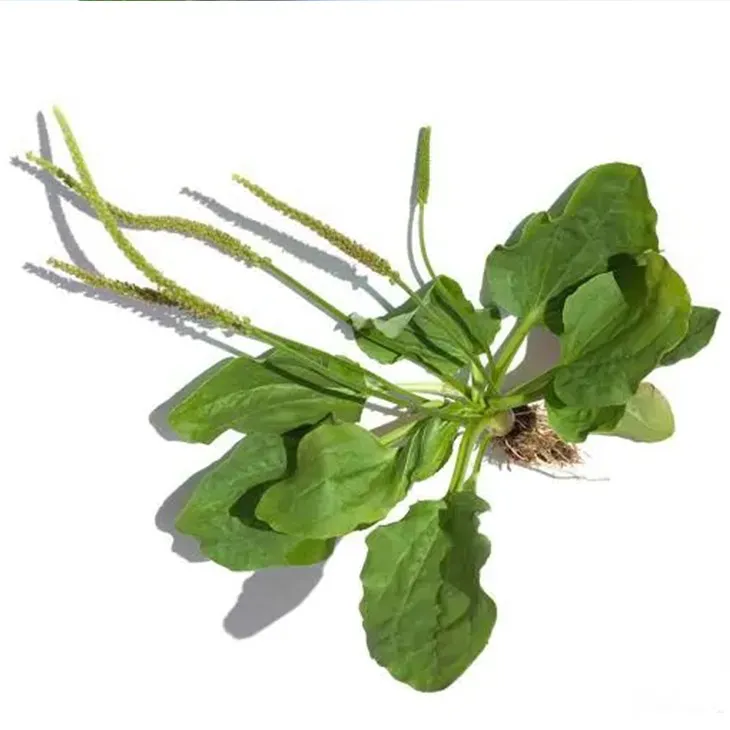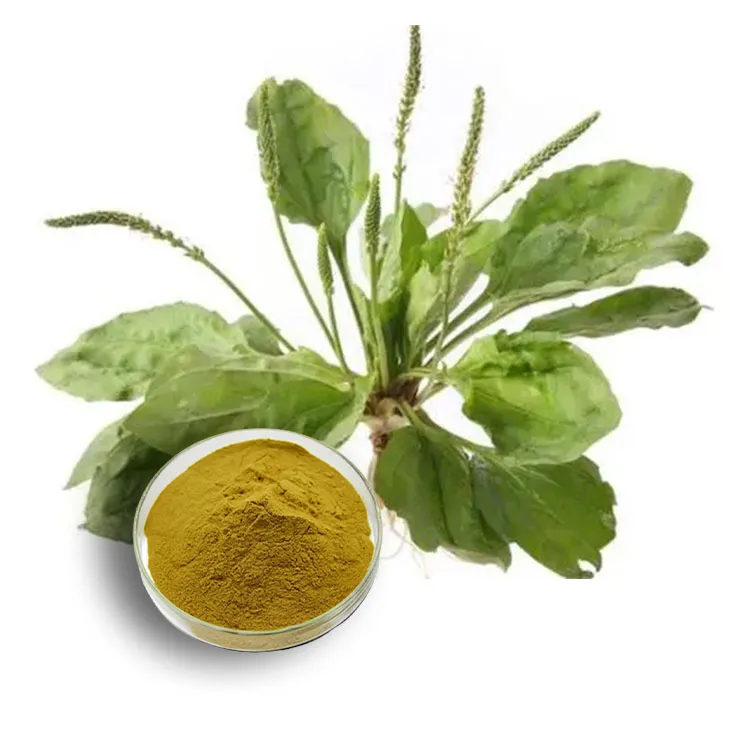- 0086-571-85302990
- sales@greenskybio.com
Extraction process of plantain extract.
2024-11-29

1. Introduction
Plantain extract has been increasingly recognized for its numerous beneficial properties in various fields such as pharmaceuticals, cosmetics, and traditional medicine. The extraction process is crucial to obtain a high - quality extract that can be effectively utilized. This article will delve into the detailed extraction process of Plantain extract.

2. Collection of Plantain
The first step in the extraction process is the collection of fresh plantain. Quality and freshness are of utmost importance at this stage.
2.1 Selection Criteria
When collecting plantain, certain selection criteria need to be met. The plantain should be free from obvious signs of disease, damage, or pest infestation. Healthy plantain leaves and stems are typically targeted for collection. For example, the leaves should have a vibrant green color and firm texture, indicating their freshness and vitality.
2.2 Ideal Collection Time
The ideal collection time also plays a significant role. It is often recommended to collect plantain during its growth peak. This is usually when the plant has reached a certain level of maturity but has not yet started to wither or decay. Different regions may have slightly different optimal collection times depending on the local climate and growing conditions.

3. Washing of Plantain
Once the plantain is collected, it must be washed thoroughly. This step is essential to eliminate dirt and contaminants that may be present on the plantain.
3.1 Gentle Washing Technique
A gentle washing technique is preferred to avoid damaging the plantain. Cold or lukewarm water can be used for washing. The plantain should be gently swirled in the water to dislodge any dirt particles. Using a soft brush may be necessary in some cases, especially for areas where dirt may be more stubbornly adhered, such as the undersides of the leaves or along the stems.
3.2 Multiple Washing Rounds
Often, a single washing may not be sufficient. Multiple washing rounds are usually carried out to ensure that all dirt and contaminants are removed. After each washing, the water should be drained completely before the next round of washing. This helps to prevent the re - deposition of dirt on the plantain.

4. Drying of Plantain
After washing, drying is a necessary step to prepare the plantain for extraction. Drying helps to reduce the moisture content of the plantain, which is important for the subsequent extraction process.
4.1 Natural Drying
Natural drying is a common method. The washed plantain can be spread out in a well - ventilated area, away from direct sunlight. This allows the moisture to evaporate gradually. However, natural drying may take a relatively long time, especially in humid environments. The plantain should be turned regularly during the drying process to ensure even drying. For example, it can be turned every few hours to expose all parts of the plantain to the air.
4.2 Artificial Drying
Artificial drying methods can also be employed when a faster drying process is desired. Dehydrators or low - heat ovens can be used. When using an oven, the temperature should be set at a low level, typically around 40 - 50°C, to avoid over - drying or burning the plantain. The drying time will depend on the quantity of plantain and the drying equipment used. It is important to monitor the drying process closely to ensure that the plantain is dried to the appropriate moisture level.
5. Extraction Techniques
Once the plantain is dried, different extraction techniques can be employed to obtain the Plantain extract.
5.1 Maceration
Maceration is a common and traditional method for plantain extraction. In this process, the dried plantain is soaked in a solvent over a period.
5.1.1 Selection of Solvent
The selection of the solvent is crucial. Commonly used solvents include ethanol, methanol, and water. Ethanol is often preferred as it can effectively dissolve the desired compounds in plantain while being relatively safe and easy to handle. The concentration of the solvent may also vary depending on the specific requirements of the extraction. For example, a 70% ethanol solution is often used in many cases.
5.1.2 Maceration Conditions
The maceration conditions need to be carefully controlled. The plantain and the solvent are placed in a sealed container. The container is then stored at a relatively constant temperature, usually in a cool and dark place. The maceration time can range from a few days to several weeks. Longer maceration times may be required for a more complete extraction of the compounds. During the maceration process, the container can be gently shaken or stirred occasionally to enhance the extraction efficiency.
5.2 Soxhlet Extraction
Soxhlet extraction is another extraction technique that can be used for plantain extract. This method is more suitable for continuous extraction.
5.2.1 Soxhlet Apparatus Setup
The Soxhlet apparatus consists of a flask, a condenser, and an extraction chamber. The dried plantain is placed in a thimble, which is then inserted into the extraction chamber. The solvent is placed in the flask. As the solvent is heated, it vaporizes, rises into the condenser, and then condenses back into the extraction chamber, continuously extracting the compounds from the plantain.
5.2.2 Advantages and Disadvantages
One advantage of Soxhlet extraction is its high extraction efficiency, especially for compounds that are difficult to extract by simple maceration. However, it also has some disadvantages. It requires more complex equipment and is more time - consuming compared to simple maceration. Additionally, the high - temperature extraction process may cause some degradation of certain heat - sensitive compounds in the plantain.
6. Separation and Purification
After the extraction process, the resulting mixture needs to be separated and purified to obtain a pure plantain extract.
6.1 Centrifugation
Centrifugation is a common method for separating the solid and liquid parts of the extraction mixture. The extraction mixture is placed in a centrifuge tube and spun at a high speed. This causes the heavier solid particles to sediment at the bottom of the tube, while the liquid extract can be easily decanted or aspirated.
6.2 Filtration
Filtration is another important separation method. A filter paper or a membrane filter can be used. Filtration helps to remove any remaining small solid particles from the extract, resulting in a clearer extract. Gravity filtration or vacuum filtration can be employed depending on the specific requirements. Gravity filtration is a simple and slow process, while vacuum filtration is faster but requires additional equipment.
6.3 Distillation
Distillation can be used for further purification of the plantain extract. It is based on the difference in boiling points of the components in the extract.
6.3.1 Simple Distillation
Simple distillation is suitable for separating the solvent from the extract if the solvent has a relatively low boiling point. The extract - solvent mixture is heated, and the solvent vaporizes first and is then condensed and collected separately, leaving behind a more concentrated plantain extract.
6.3.2 Fractional Distillation
Fractional distillation is used when there are multiple components in the extract with different boiling points. This method can separate the components more precisely, allowing for the isolation of specific active compounds in the plantain extract.
6.4 Chromatography
Chromatography is a powerful technique for purifying plantain extract. It can separate the different compounds in the extract based on their different affinities for the stationary and mobile phases.
6.4.1 Thin - Layer Chromatography (TLC)
TLC is a simple and rapid chromatography method. A thin layer of adsorbent material, such as silica gel, is coated on a plate. The plantain extract is spotted on the plate, and a solvent is used as the mobile phase. As the solvent moves up the plate, the different compounds in the extract separate based on their interaction with the adsorbent and the solvent. TLC can be used for preliminary analysis and purification of the extract.
6.4.2 High - Performance Liquid Chromatography (HPLC)
HPLC is a more advanced chromatography technique. It can provide high - resolution separation of the compounds in the plantain extract. The extract is pumped through a column filled with a stationary phase, and a solvent is used as the mobile phase. The different compounds are detected as they elute from the column, allowing for precise identification and purification of the active compounds in the plantain extract.
7. Conclusion
The extraction process of plantain extract involves multiple steps, from the collection of fresh plantain to the final purification of the extract. Each step is crucial in obtaining a high - quality plantain extract with beneficial properties. With the development of extraction techniques, more efficient and precise methods are being explored to meet the increasing demand for plantain extract in various industries.
FAQ:
What is the first step in the extraction process of plantain extract?
The first step is the collection of fresh plantain.
Why is it necessary to wash the plantain?
It is necessary to wash the plantain thoroughly to eliminate dirt and contaminants.
What is maceration in the context of plantain extract extraction?
Maceration is a common method in the extraction of plantain extract. It involves soaking the dried plantain in a solvent over a period to draw out the desired compounds.
What happens after maceration in the extraction process?
After maceration, the mixture is centrifuged or filtered to obtain a crude extract.
Why is further refinement like distillation or chromatography carried out?
Further refinement through distillation or chromatography is carried out to purify the extract, ensuring a pure and effective plantain extract for use in pharmaceuticals, cosmetics, etc.
Related literature
- The Extraction and Application of Plantain Extract in Herbal Medicine"
- "Optimizing the Extraction Process of Plantain Extract for Cosmetic Use"
- "A Comprehensive Study on Plantain Extract Extraction Techniques"
- ▶ Hesperidin
- ▶ citrus bioflavonoids
- ▶ plant extract
- ▶ lycopene
- ▶ Diosmin
- ▶ Grape seed extract
- ▶ Sea buckthorn Juice Powder
- ▶ Beetroot powder
- ▶ Hops Extract
- ▶ Artichoke Extract
- ▶ Reishi mushroom extract
- ▶ Astaxanthin
- ▶ Green Tea Extract
- ▶ Curcumin Extract
- ▶ Horse Chestnut Extract
- ▶ Other Problems
- ▶ Boswellia Serrata Extract
- ▶ Resveratrol Extract
- ▶ Marigold Extract
- ▶ Grape Leaf Extract
- ▶ blog3
- ▶ blog4
-
Organic Non - GMO Camu - Camu Fruit Extract.
2024-11-29
-
Nature's Bounty Copaiba Extract.
2024-11-29
-
The pure L - carnitine most worth buying.
2024-11-29
-
The best organic quercetin.
2024-11-29
-
Nature's Bounty Vitamin K2
2024-11-29
-
Andrographis Paniculata Extract Powder
2024-11-29
-
Astaxanthin
2024-11-29
-
Camu Camu Extract
2024-11-29
-
Bitter Melon Extract
2024-11-29
-
Troxerutin
2024-11-29
-
Panax Ginseng Leaf Extract
2024-11-29
-
Saffron Extract Powder
2024-11-29
-
Plantain extract
2024-11-29
-
Almond Extract Powder
2024-11-29
-
Wheat Germ Extract
2024-11-29




















